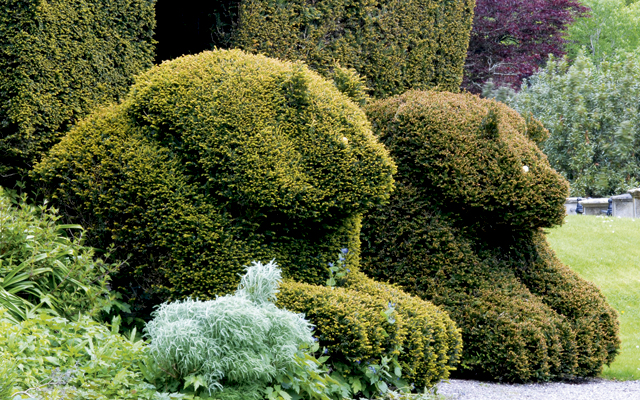Top tips for topiary
Topiary lifts seasonal gloom and gives the garden a clean, solid framework.


The time of year is nigh when I’m grateful for my topiary. The autumn show of rainbow-tinted foliage on deciduous trees and shrubs is pleasingly spectacular, but, subsequently, it’s hard to work up enthusiasm for naked branches silhouetted against a gun-metal sky.
Over the years, I’ve built up a substantial topiary collection after 150 specimens, I stopped counting. And yet the one acre that we garden fairly intensively doesn’t, to my eye, seem to be over-stocked. The orbs and cones, pyramids and domes sit comfortably within its confines and, in winter, as the leaves fall away from other plants, they come to the fore and give the garden a solid framework that has a clean-limbed quality.
Like most gardeners, I’m wary of planting more box since its recent martyrdom to blight disease, but yew thrives on our chalky soil, so it’s a safer choice and it quietly gets on with growing, without making a fuss. Neither is it as slow-growing as many people claim, putting on a good 9in a year here and establishing happily, especially when planted out from container-grown stock. Bare-rooted yew trees can be a tad ‘iffy’ when it comes to putting their roots down (especially if they’re allowed to dry out) and I find it’s better to spend a little more on pot-grown plants that will settle in without setback.
That said, there is one kind of situation in which yew won’t thrive and that’s boggy ground. It deeply resents waterlogging and will curl up and die if a patch of earth is badly drained. Prolonged flooding is not to its liking.
We clip our yew once a year, in September. In its formative years, pruning twice a year helps plants to thicken up, but, once the final shape has been achieved, clipping when the main summer growth spurt has abated will leave it with a crisp outline through the winter and reduce the amount of labour needed.
Tidy-minded gardeners who can’t bear fuzzy yew hedges and topiary will make their foray with the shears or powered trimmers as early as June or July, but that will only encourage further growth that has to be tackled at summer’s end, resulting in two clipping sessions rather than one.
There are many ways in which yew can be used: as a tall or short hedge, trimmed to a crisp, symmetrical outline, or cut to produce a more billowing appearance so that it looks like giant dumplings, like those monsters at Powis Castle in Wales. After many years, when ancient yew hedges have outgrown their space, they can be cut back hard to bare stems from which new shoots will sprout. If the hedge is well established, you won’t kill it by engaging in such apparent butchery (although do it one side at a time). After a few years, it will fill out and become reinvigorated.
Exquisite houses, the beauty of Nature, and how to get the most from your life, straight to your inbox.
Topiary obelisks and tapering pyramids are exceptionally elegant in winter. They act like giant gnomons on a sundial, casting long shadows that move with the hours. They give formal walks and pathways a majestic appearance. In that spirit, the 8ft cones of yew that line our drive were, last year, trimmed into a more interesting shape, creating, on alternate specimens, a cube at the bottom, a sphere in the centre and a smaller cone at the top. The effect isn’t overly fussy, as we left the rest alone.
Aside from a topiary duck and a hen (both of box), I haven’t gone in for animals. I created yew peacocks flanking a path in our last garden and felt that my ornithological topiary had had sufficient expression.
Country Life is unlike any other magazine: the only glossy weekly on the newsstand and the only magazine that has been guest-edited by His Majesty The King not once, but twice. It is a celebration of modern rural life and all its diverse joys and pleasures — that was first published in Queen Victoria's Diamond Jubilee year. Our eclectic mixture of witty and informative content — from the most up-to-date property news and commentary and a coveted glimpse inside some of the UK's best houses and gardens, to gardening, the arts and interior design, written by experts in their field — still cannot be found in print or online, anywhere else.
